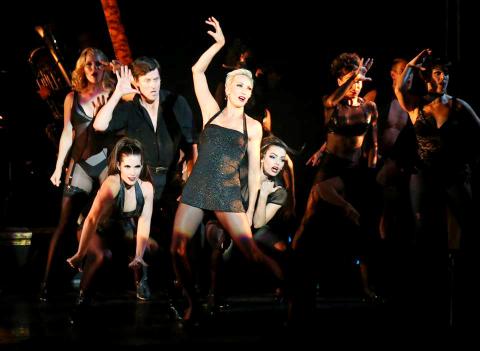They had me at the first shoulder roll and hip jut.
I had almost forgotten how much I loved Bob Fosse’s unique dance style until the first cast members of Chicago The Musical strutted onto the stage of the Sun Yat-sen Memorial Hall on Friday night and there was that first wah-wah of the trumpet.
I had gone to the show with admittedly low expectations because I hate the sound system at Sun Yat-sen; it has been the ruin of too many dance performances over the years. The first international touring production of Chicago to come to Taipei played at the National Theater in 2005, and I was bitterly regretting not having seen it then.

Photo Courtesy of Chen Li-kai / udnFunLife
However, the cast of the current tour, led by Dylis Croman as Roxie Hart and Amra-Faye Wright as Velma Kelly, and the 13-member orchestra, conducted by Rob Bowman, were so terrific that they soared above the theater’s deficiencies, despite an occasional weak spot or two (like the Class duet).
Wright, backed by the black-clad chorus members, vamped her way through the opening number, All That Jazz, setting the stage for what was to come, while Croman first showed her comedic and singing chops from halfway up a ladder on the right-hand side of the proscenium frame in Funny Honey.
Brent Barret, with a wonderful tenor, is so smoothly slick as the lawyer Billy Flynn that he could have been coated in Teflon, while Roz Ryman as Matron “Mama” Morton has a powerful voice with a rumbling laugh that can shake the dust off the rafters. She earned big laughs with her kisses and side comments to the audience.
Ron Orbach was heartbreaking poignant in Mr Celophane, while Lauren Gemelli as Liz and Nicole Benoit as the Hungarian Hunyak stood out in the Cell Block Tango.
As good as the stars and the rest of the cast are, the British musicians alone are worth the price of admission; they rocked the joint.
Fosse created Chicago as a vaudeville review, with most of the cast taking on a variety of roles and minimal costume changes and props, though the man did like chairs. The set, like the Broadway original, is simple, just a multi-tiered structure for the orchestra that also serves as the entryway and exit for the leads, as well as allowing them to interact with Bowman.
Given the shallowness of the Sun Yat-sen’s stage, the orchestra’s box takes up most of the floor, but the narrow horizontal strip that was left in front of it never felt too crowded, even in the chorus numbers, because of the clever placing of the cast, including the very tall Brent Hauser, who is at least a head taller than most all of his colleagues — and there are a lot of tall women — and yet rarely stands out from them.
However, it is the music and lyrics by John Kander and Fred Ebb, and most of all the sexy, snappy choreography — by Ann Reinking in Fosse’s style — for this revival created in 1996 that are the heart of Chicago and they remain as fresh, captivating and cynical as ever. It is easy to see why it is the longest-running American musical on Broadway.
The storyline is also amazingly relevant to today: in the 1920s, someone like Roxie Hart wanted to see her name in the newspapers, and her character hoped to parlay a murder trial into a vaudeville career — today it is the “accidental release” of a sex tape or an Instagram account that could lead to a reality television show and fame.
The rest of the audience appeared as enraptured as I was on Friday, with each number earning a big round of applause, and, thanks to a great translation of the script and lyrics on the surtitle boxes, were able to keep up with the fast-paced dialogue, quips and double entendres. There was an almost palpable flow of energy between the performers and the audience.
I ran into cast member Shamicka Benn afterwards and she said all the performers were thrilled by the responsiveness of the audiences in Taipei, which was in stark contrast to the very reserved receptions they received during a nine-week run in South Korea and a month in Japan that preceded their arrival in Taiwan.
Taipei rarely gets a musical that is as much rollicking fun as this version of Chicago, so go see it if you have the chance. There are six more performances of the show, which runs through Sunday, and tickets are available through tickets.udnfunlife.com or convenience store ticket kiosks.
BALLET GALA
The following night, Program A of the 11th International Ballet Star Gala in Taipei (第十一屆 國際芭蕾舞星在台北) at the National Theater fully lived up to expectations and then some.
All of the dancers — Friedemann Vogel and Elisa Bandenes from the Stuttgart Ballet, Elisa Carrillo Cabrera and Mikhail Kaniskin from the Staatsballett Berlin, the National Ballet of Canada’s Svetlana Lunkina and Evan McKie, San Francisco Ballet principals Maria Kochetkova and Carlo Di Lanno, the Bolshoi Theatre principal Evgenia Obraztsova, freelancers Taras Domitro and Adiarys Almeida, and perennial crowd favorites Daniil Simkin of the American Ballet Theater and Igor Kolb of the Mariinsky Theatre were in great form.
The highlights included the rare chance to see something from British choreographer David Dawson — the White Swan Pas de Deux from his very contemporary Swan Lake— danced by Lunkina and McKie left me eager to see the whole production.
John Cranko’s Legende, danced by Bandenes and Vogel was breathtakingly beautiful, as was the Caravaggio Pas de Deux danced by Carrillo and Kaniskin, while Badenes just sizzled in Katarzyna Kozielska’s very modern Limelight.
I was a bit disappointed that the show’s finale was the old gala warhorse, the Don Quixote Pas de Deux, but then Almeida and Domitro performed their solo variations and shut down any complaints.
She nailed her fouettes, turning several into doubles, but not moving her toeshoe on the floor a centimeter from its starting point; it was if she had a rod through her body holding her in place.
Domitro’s series of ronde de jambes saw him achieve a perfect horizontal spilt again and again as he circled the stage.
KAOHSIUNG CITY BALLET
Last, but not least, the Kaohsiung City Ballet (KCB, 高雄城市芭蕾舞團) will be giving its final performance of Light (光) at the Pingtung County Art Center on Saturday, after shows in Kaohsiung last month and Taichung on Tuesday.
The production is made up of two works, both entitled Light and both using Vivaldi’s The Four Seasons, the first by Lai Hung-chung (賴翃中) and the second by Romanian choreographer/multimedia artist Constantin Georgescu.
Lai’s piece, set on Cheng I-han (鄭伊涵), Chien Lin-yi (簡麟懿), Huang Lu-kai (黃律開) and Chang Yu (張瑀) is all contrasting darkness and light.
Cheng’s opening solo is starkly beautiful, as are her duets with Chien — once again they prove to be a powerful, dramatic partnership.
The piece works well when Lai sticks to solos and duets; when he moves into a pas de trois and then has all four dancers together later on, he runs into trouble, but it is nothing that some polishing and tweaking cannot fix.
Georgescu’s piece is really a series of moving paintings created by his dancers and video projections of them, shot from above.
The piece is about connections — the red silken ropes that connect the dancers — and disconnections.
It is a beautiful series of pairings, solos and group dances; the only problem is projections, sometimes with just a stop/delay of a few seconds, can be so engrossing that the viewer forgets to look at the performers who are creating the images.

Taiwan Power Co (Taipower, 台電) and the New Taipei City Government in May last year agreed to allow the activation of a spent fuel storage facility for the Jinshan Nuclear Power Plant in Shihmen District (石門). The deal ended eleven years of legal wrangling. According to the Taipower announcement, the city government engaged in repeated delays, failing to approve water and soil conservation plans. Taipower said at the time that plans for another dry storage facility for the Guosheng Nuclear Power Plant in New Taipei City’s Wanli District (萬里) remained stuck in legal limbo. Later that year an agreement was reached

What does the Taiwan People’s Party (TPP) in the Huang Kuo-chang (黃國昌) era stand for? What sets it apart from their allies, the Chinese Nationalist Party (KMT)? With some shifts in tone and emphasis, the KMT’s stances have not changed significantly since the late 2000s and the era of former president Ma Ying-jeou (馬英九). The Democratic Progressive Party’s (DPP) current platform formed in the mid-2010s under the guidance of Tsai Ing-wen (蔡英文), and current President William Lai (賴清德) campaigned on continuity. Though their ideological stances may be a bit stale, they have the advantage of being broadly understood by the voters.

In a high-rise office building in Taipei’s government district, the primary agency for maintaining links to Thailand’s 108 Yunnan villages — which are home to a population of around 200,000 descendants of the Chinese Nationalist Party (KMT) armies stranded in Thailand following the Chinese Civil War — is the Overseas Community Affairs Council (OCAC). Established in China in 1926, the OCAC was born of a mandate to support Chinese education, culture and economic development in far flung Chinese diaspora communities, which, especially in southeast Asia, had underwritten the military insurgencies against the Qing Dynasty that led to the founding of

Artifacts found at archeological sites in France and Spain along the Bay of Biscay shoreline show that humans have been crafting tools from whale bones since more than 20,000 years ago, illustrating anew the resourcefulness of prehistoric people. The tools, primarily hunting implements such as projectile points, were fashioned from the bones of at least five species of large whales, the researchers said. Bones from sperm whales were the most abundant, followed by fin whales, gray whales, right or bowhead whales — two species indistinguishable with the analytical method used in the study — and blue whales. With seafaring capabilities by humans